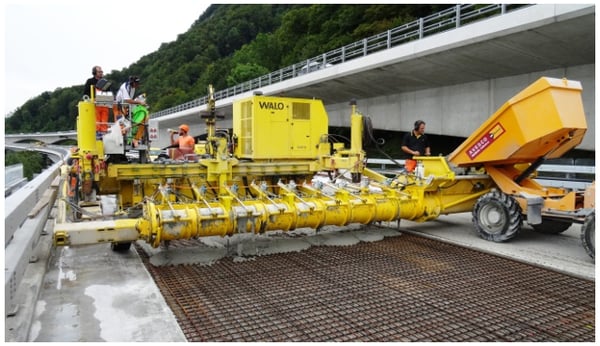“Bridge preservation is defined as actions or strategies that prevent, delay or reduce deterioration of bridges or bridge elements, restore the function of existing bridges, keep bridges in good condition and extend their life.” – Department of Transportation Bridge Preservation Guide
Article last updated on 9/25/2019.
Bridge Preservation for Deck Maintenance
In its Bridge Preservation Guide, the U.S. Department of Transportation (DoT) explains that bridge infrastructure needs, “A strategic, systematic, and balanced approach to managing bridge preservation and replacement needs.”
An effective bridge preservation project always enacts specific and intentional solutions in one area needing repair or replacement (joints, deck overlays) that can then contribute to the overall grade of the bridge for many years to come.
When looking at bridge preservation, there are several options to pursue. We’ve explained four of them below pertaining to deck maintenance to highlight the different solutions available for this part of a bridge, however this is not an exhaustive list. We believe, like the U.S. Department of Transportation, that the following options are, “Considered [highly] cost effective when applied to the appropriate bridges at the appropriate time using quality material and workmanship.”
Preventative Maintenance - Factors to Consider
Before choosing a bridge preservation solution, a DOT Engineer surveys a bridge deck. General factors under consideration include:
- Age of Deck
- Chloride Contamination
- Deck Condition ( % delamination)
- Areas of Efflorescence (viewed from the deck underside)
- Structural Widening
- Load Rating
- General Super- and Substructure Condition
An initial challenge requires prioritizing which area to apply preventative maintenance to first. Next, it is important to consider how much the repair will cost in time and money.
Preventative Solutions for Deck Maintenance
Traditional deck maintenance solutions focus on removing damaged materials, restoring their condition, and preventing further damage from recurring.
1. Deck Joints

Bridge deck joints control the contraction and expansion of concrete bridges. A compromised joint, for example if one is leaking, creates a chain of problems extended well beyond the joint itself. When a leaking joint is sealed, the deterioration of superstructure and substructure elements beneath the joints are minimized, allowing the bridge to last longer with this single area of repair.
2. Deck Overlays
The Federal Highway Association has found, “Deck overlays significantly increase the life of the deck by sealing the deck surface from aggressive solutions and reducing the impact of aging and weathering.” Quality overlay solutions should include waterproofing and have low permeability.
A highly regarded deck overlay material is Ultra High Performance Concrete (UHPC). UHPC has a proven ability to add longevity and reliability to bridges that require preventative maintenance. A UHPC deck overlay is a quick turnaround solution that provides decades of additional life to a bridge. Additionally, the lifecycle cost of UHPC overlay is significantly lower than other deck overlay materials.

3. Cathodic Protection Technology
This technology controls the corrosion of steel. An anode is created by connecting the metal needing to be protected (in this case reinforcing steel encased in the concrete bridge deck) to a more easily corroded ‘sacrificial metal’. The connection causes the sacrificial metal to corrode instead of the reinforcing steel, arresting further corrosion and extending the life of the bridge.
4. Electrochemical Chloride Extraction Treatment
Lastly, Electrochemical Chloride Extraction is recognized as another effective and cost-efficient solution. Similar to Cathodic Protection, this method uses an anode of sacrificial metal to pull chlorides around the reinforcing steel. In the U.S. DoT’s Bridge Preservation Guide, the extraction process, “Removes the chloride ions from the vicinity of the reinforcing steel and thus eliminates the source of corrosion.” For additional information, ScientificReports provides an in-depth article on the “Effects of chloride ions on corrosion of ductile iron and carbon steel."
A Plan with UHPC Solutions
An effective bridge preservation program, as stated in the definition above needs to be “strategic, systematic and have a balanced approach.” The Indiana DoT Bridge Rehabilitation Group explains the design process for a deck overlay with a mindset toward bridge maintenance and rehabilitation:
1) Employs long-term strategies and practices at the network-level to preserve the condition of bridges and to extend their useful life.
2) Has sustained and adequate resources and funding sources.
3) Has adequate tools and processes to ensure that the appropriate cost effective treatments are applied at the appropriate time.
UHPC Solutions aims to solve the problem of deteriorating U.S. infrastructure by adhering to the aforementioned concepts, by exclusively using UHPC as it is the longest lasting overlay material available today. Further, UHPC Solutions utilizes cutting edge technology such as hydrodemolition machines to properly repair bridge infrastructure.
Hydrodemolition is extremely beneficial when rehabilitating bridges, as it is a safe non-impact alternative that reduces the risk of microcracking and provides substrate surfaces with better bonding than those obtained on a scarified substrate surface.
Additionally, a UHPC overlay adds decades to the life of a bridge, limiting the need for successive repairs or even complete replacement which results in added expenses. However, it is essential that repairs are applied in a timely manner before corrosion migrates through bridge decks and onto the lower mat or reinforcing steel.
Our partner companies, WALO and Posillico, have completed some of the largest bridge rehabilitation projects worldwide using Ultra High Performance Concrete. We’re ready to serve and bring this solution to your bridge or building project.




